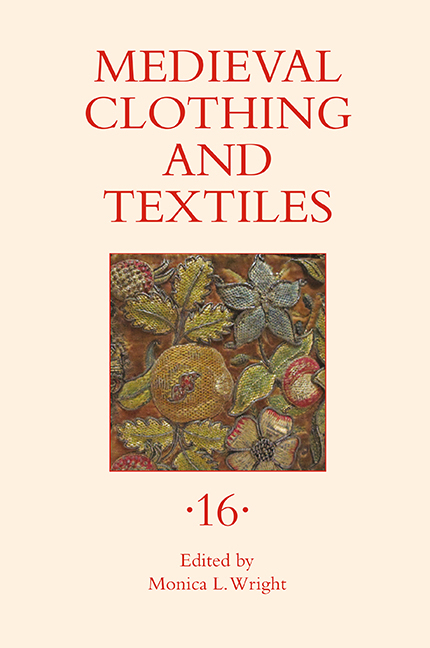Book contents
- Frontmatter
- Contents
- Illustrations
- Tables
- Contributors
- Preface
- 1 Anglo-Saxon Banners and Beowulf
- 2 The Use of Curved Templates in the Drawing of the Bayeux Tapestry
- 3 Construction and Reconstruction of the Past: The Medieval Nordic Textile Heritage of Hemp
- 4 Historicizing the Allegorical Eye: Reading Lady Mede
- 5 Sex, Lies, and Verdugados: Juana of Portugal and the Invention of Hoopskirts
- 6 Fashion and Material Culture in the Tabletop of the Seven Deadly Sins Attributed to Hieronymus Bosch
- 7 The Broderers’ Crown: The Examination and Reconstruction of a Sixteenth-Century City of London Livery Company Election Garland
- Appendix 7.1 Surviving Sixteenth-and Seventeenth-Century Embroidered Crowns of the City of London Livery Companies
- Recent Books of Interest
- Author Index, Volumes 1–15
4 - Historicizing the Allegorical Eye: Reading Lady Mede
Published online by Cambridge University Press: 27 March 2021
- Frontmatter
- Contents
- Illustrations
- Tables
- Contributors
- Preface
- 1 Anglo-Saxon Banners and Beowulf
- 2 The Use of Curved Templates in the Drawing of the Bayeux Tapestry
- 3 Construction and Reconstruction of the Past: The Medieval Nordic Textile Heritage of Hemp
- 4 Historicizing the Allegorical Eye: Reading Lady Mede
- 5 Sex, Lies, and Verdugados: Juana of Portugal and the Invention of Hoopskirts
- 6 Fashion and Material Culture in the Tabletop of the Seven Deadly Sins Attributed to Hieronymus Bosch
- 7 The Broderers’ Crown: The Examination and Reconstruction of a Sixteenth-Century City of London Livery Company Election Garland
- Appendix 7.1 Surviving Sixteenth-and Seventeenth-Century Embroidered Crowns of the City of London Livery Companies
- Recent Books of Interest
- Author Index, Volumes 1–15
Summary
Allegory often presents readers with clear descriptions of characters whose appearance parallels their metaphorical role. Readers of allegory—especially scholars—are also trained to read clothing this way: to look for allegorical conventions as an explanation for physical descriptions. Thus, one might read the ambivalent description of Lady Fortune in John Skelton's Bowge of Court—featuring both alluring and dangerous attributes—and connect it to other depictions in Chaucer's Book of the Duchess. The general explanation is that the character looks the way he or she does because that is how that allegorical character traditionally appears: Fortune is good to some and terrible to others simply because that is how Fortune appears in allegory.
Ostensibly, William Langland's Piers Plowman follows the same trend, giving a garish, ostentatious robe—complete with a dozen lines of description—to Lady Mede, who is the personification of reward, recompense, or the desire for worldly gain. When Will, the narrator, first meets Mede, he is told that her clothing shows her to be a liar and a seductress, an interpretation a modern reader may find all too intuitive.
I am interested in complicating this way of reading in a few ways. First, the reliance on literary convention has a way of insulating allegory from historical trends and changes in material culture. Piers Plowman was published in three different editions, so-called the A-, B-, and C-texts respectively. As A. V. C. Schmidt's definitive introduction explains, the texts represent “three successive states of a single work by one man” working over twenty to twenty-five years. The A-text is but 2,540 lines, whereas the B is a complete revision of the earlier work and nearly three times as long. The C is yet a further revision of the B, but maintains a similar length. The three texts are estimated to have been produced from 1367 to the mid-1380s. This timeline is important, as it covers the period when fashion was on the rise in Western Europe, which in turn spurred radical disagreement as to the transformative potential of clothing. The first half of this article will show how Langland consistently provides enough nuanced characterization that the one-noted costumes begin to lose their ability to signify accurately.
- Type
- Chapter
- Information
- Medieval Clothing and Textiles 16 , pp. 85 - 100Publisher: Boydell & BrewerPrint publication year: 2020



